Concave
October 2013.
This is how the bases of our Burton snowboards looked after we (my son
and I) had returned from our last 6 days trip to Hemsedal, Norway in
February 2013. We returned from the trip with the impression that our
boards had performed a bit more nervously than expected. Perhaps not
surprising when taking a closer look at the pictures (click the pictures
to enlarge).
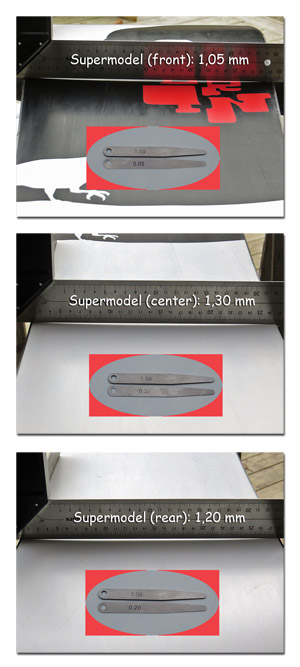
Click the picture to enlarge.
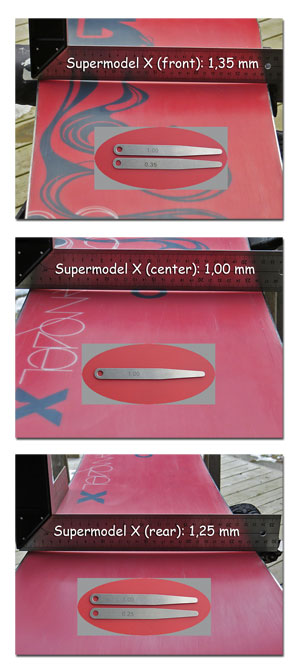
Click the picture to enlarge.
As can
be seen, the
boards are extremely concave (the bindings are removed from the boards).
Before we actually measured for concavity, we ordered some base
flattener tools from SkiVisions (http://skivisions.us/).
But when we realized just
how
concave the boards were,
we gave up using the tools,
since (to our knowledge) the P-Tex layer
is just around
1.2 millimetres thick.
There
simply wouldn't be any P-Tex left around the edges
by the time the bases would eventually be level. So, what to do?
Well, you
could
of course
throw
away
the boards, and
sadly
that might
be the end of it. But
since ...
- replacement boards aren't exactly cheap,
- at least until our last snowboard trip we've been very pleased with the boards,
- our bindings (CO2
EST)
are dedicated to the
the bindings (we are, for good reasons, pretty reluctant to buy Burton boards again),
... we'll go to great lengths in trying to fix the concavity of the boards.
In the text below you'll find a few words on what the boards have been exposed to, followed by Burton's own comments, as well as a short discussion on what seems to us to be the most probable cause(s) for the concavity. Finally, you'll find a description of the steps that we've taken in a rather desperate attempt to remove the concavity from the boards.
What have the boards been exposed to?
Time of usage.
As
is evident from the
pictures, the boards
in question
are a Burton Supermodel 159 and a
How
have the boards
been used and stored.
I'm 63 years old and
have been snowboarding for 12 years. My son
is 25 years old and has been
snowboarding for 8 years. We're certainly no daredevils
and
mainly visit the groomies with
some very short excursions to the non-prepped
areas. Here's a headcam video from our last trip,
to show
that we
are not
mistreating our
snowboards:
https://vimeo.com/62104509;
"Mikkel" is the Supermodel rider and the headcam man is the Supermodel X
rider.
When not in use, the
boards have been kept dry in room temperature. Coming home from our
trips we always do an
interim preparation
of the boards
for the next season (drying the boards, preparing the rails and bases).
The bindings have not been removed during the storage period.
Contacting
the retailer and the Danish importer to
get an idea of what might have happened.
Contacting our
retailer (
Our retailer tried
again ("...
I
hope you can do better than this!"), but in essence
he
only got a repeat
of the same answer ("...that's the closest I can get
...").
In fact it
could have been a kind of answer - if
But
Developing some theory about what might have happened.
To
outline
some plausible
causes
for the
Supermodel/Supermodel X
concavity,
we first have to find out what could
not
be the cause.
1) It's not impossible, but not probable either, that the boards were manufactured at the same time. We're not even sure if the boards
were manufactured at the same facility. And according to the specs, the boards are not made from quite the same materials (but
close).
So,
because of the presumably lack of identity between
manufacture time, manufacture facility and board material it's
most likely that the boards were OK when they were sent
to
2)
To check
whether
concavity
is common in new boards,
we controlled
some new boards (around 50, most
our
retailer. Non of them had the slightest hint of
concavity.
So, it's
most likely that the boards were OK when we brought them home from our
retailer. Perhaps underlined by the fact that the boards
were bought at the same place - but not at
quite
the same time.
3) The boards have been kept in a dark, dry, temperate room between our snowboard trips. Temperate means between 15 - 25 degrees
Celsius.
So, the
boards have never been exposed to excessive
humidity, heat or the like. Yes, the boards have been exposed
to
cold (down to approx. -20 degrees Celsius) on our trips, but
we
suppose
that's what the snowboards are built for
...
4)
The boards have never been in contact with any base or edge grinding
machine, structure machine, waxing machine, or the like.
The boards have exclusively been prepared by hand with a Toko waxing iron (always in motion!), a plastic scraper and some Burton
and Toko
edge devices. And the waxes used have almost always been from the Swix
LF series.
So, the
boards have always been carefully prepared,
both when returning from our trips and just before departing
on one.
5) When transporting the boards to the Norwegian destinations, they have been kept in padded DaKine board bags in a roof box on
our car.
So, the
boards have been transported carefully, lying loose and
protected in padded board bags in a roof box.
But then, what
might
have
triggered
the concavity?
1)
When searching the internet it seems that some guys (claiming to have
been working within the industry for years) argue that "
boards are notorious for poor quality construction", and that "80% of the (Burton) boards that came through our shops were
borderline or completely untuneable because the base becomes concave"
(http://www.bikeforums.net/archive/index.php/t-74699.html).
We haven't got the faintest idea if this is true or just a rumour. Perhaps the dominance of a brand will always result in such
accusations, or perhaps lots of people have actually experienced massive quality problems. We don't know. But at least it seems that
it's not quite
unthinkable that some
2) Our bindings (CO2 EST) have always been fixed to the boards. Tightly, but certainly not by using excessive force. Of course, the
bindings have been loosened
when tweaking with the stance and angles, but they've
never
been removed for a longer period of time.
Is it feasible that the continuous pull in the channels from the bindings could have pulled the boards concave? We've all seen what
always happens under the boards that use the standard 4 screw mounts ("binding suck"), but here we're talking about channels in
almost 2 thirds of the running length of the boards. If the channels are weak and/or haven't been solid located in the boards it seems
(to us, at least) to be feasible that concavity in almost the whole length of the bottom of the boards could have developed. So there's
good reason to take a
closer look at the ICS mounts:
3) The boards are from the first (pre-2011) generation of ICS. The following generation of ICS seems to be a little more robust and went
from M5
bolts/mutters/thinner tracks to M6 bolts/mutters/thicker tracks. Why did
realized that the first generation of ICS were too weak to withstand the pull from the binding with concavity as a consequence?
Replacing the concave boards with new Burton snowboards?
If the
cause
of
the concavity
in
our boards
turns out to a mounting system
that is too weak (a system that
for whatever reason was beefed up from 2011 and onwards),
then there's
no apparent reason not
to replace our Supermodel and Supermodel X with new Burton snowboards
that have the post-2011 ICS, for
instance a couple of
Family Tree Juice
Wagons.
But two things hold us back:
Firstly, until we get a
confirmation that the (now dismantled) weak(?) ICS has been the main
cause for the concavity, we'll have to assume that all
And secondly, the arrogance from Burton (or the Danish Burton importer?) in refusing to give us a hint as to what can trigger a concave Burton snowboard ought not to be rewarded. Meaning that just visiting our retailer to buy a couple of new Burton boards in replacement of boards that have been destroyed from within 12-18 days in the white stuff is not the right way to go.
So, although we've owned several other Burton snowboards over the years (T6 (4 screw mount), Custom X (4 screw mount), Barracuda (post-2011 ICS mount)) - and have been very satisfied with the performance and sturdiness of the boards - unfortunately we'll have to look elsewhere in the future.
An attempt to
save our boards.
As stated,
it's impossible to remove the concavity
in our boards by using grinding
tools, as they'll just grind through the P-Tex (and probably
most of
the steel edges as
well) before the boards
are flat. The other option, of
course, is to try to press the boards into shape again. Perhaps it's a kind
of "mission impossible", but we've given this option a try.
In essence, we've
made a couple of
casts (kind of 3D prints, moulds) of the edge areas of the bottoms of the boards (in
plywood, strengthened with carbon weave). Between the edge-supporting
areas of the casts some material (plywood) has been removed, so that
when pressing very hard in the middle of the boards (by
clamps)
it's possible to press them into a convex shape.
Simply applying clamps directly on top of the boards of course exhibits unacceptable point loads, so to avoid this we've also made a couple of "casts" (again from plywood, strengthened with carbon weave) of the middle sections of the boards. So when squeezing the boards between the "casts" it's hopefully possible to bring the boards back into their original shapes by counteracting the concavity by squeezing the bottoms into a convexity. If we're very, very lucky the snowboards will have regained their original flat shape when we release the clamps. Some "check holes" are drilled into the bottom "casts" to estimate just what goes on shape-wise between the casts.
Hopefully the
pictures clarify a little.
The casts.
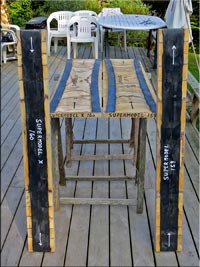
Click the picture to enlarge.
The bottom casts lying
ready.
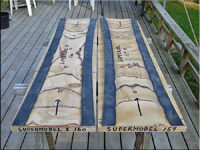
Click the picture to enlarge.
The boards in place on
the bottom casts.
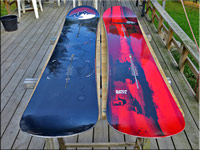
Click the picture to enlarge.
The top casts placed
on the boards.
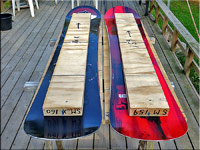
Click the picture to enlarge.
Squeezing the boards
between the casts using clamps.
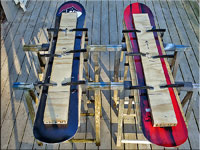
Click the picture to enlarge.
The same - upside down.
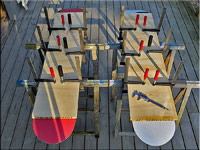
Click the picture to enlarge.
Controlling the
squeezing/shape of the bases using a vernier gauge in the "check holes"
(Supermodel).
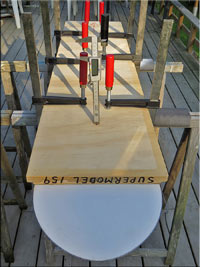
Click the picture to enlarge.
Controlling the
squeezing/shape of the bases using a vernier gauge in the "check holes"
(Supermodel X).
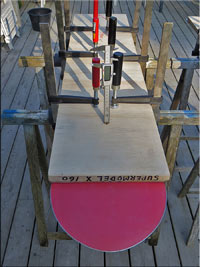
Click the picture to enlarge.
The boards have now
been squeezed for a couple of months, and soon we'll check what (if
anything) has happened. If the squeezing has had no effect,
perhaps we'll try squeezing the boards back into forms again,
this time
placing
them in a hot environment (a
sauna?)
for
a few hours. It may ruin the boards, but
then again, aren't they
ruined already?
Snowboard
concavity, does it matter at all?
As
is hopefully understood, we're not advanced snowboarders at all, and it's hard for us
to tell just how much better a flat snowboard will perform compared to
our concave snowboards. But when searching the internet for opinions on
this issue,
it's pretty obvious that even
a
smaller amount of concavity is
considered
to be
something that must
be avoided or otherwise
corrected. In our
case, we're not talking
about a smaller amount of concavity, and correcting it by conventional
means
is unfortunately not
an option.
So we'll sadly
have to trust the words of wiser
people, for instance Scott Firestone from
"alpinecarving", when he says:
"A concave base is a nightmare, because your edges will keep catching
when you try to initiate a turn or glide on the flats." (http://www.alpinecarving.com/tuning.html).
Update, spring 2014:
After a couple of
months of squeezing the boards they
have been
released from their prison. And after further a couple of weeks of
letting them lying without pressure to allow for any possible
compensating memory to work, it
is time to
valuate.
And in fact the
pressure has
worked - to some degree. There
are variations along the
lengths of the boards, but the general picture
is that the middle of
the boards (along the centre
lines)
is
almost squeezed back in position, while in the areas in between the
centre lines and the rails there still
re
some concavity. In fact the cross sections of the boards can be described as the
contours of gull wings.
Will the boards now
be worth using? Well, we'll
probably never know. Not being in a position to forsee
how the squeezing experiment would develop
and
consequently
how the boards would
react when actually hitting the snow, we had to invest in a couple of
new boards (and bindings) - just to be sure to have some quality time in
the white stuff. And of course this time we didn't opt for Burton
products, as we have lost a fair bit of confidence in their "the Cannel"
mounting system - and in the ability of Burton to back up their products
by at least producing a kind of explanation about what could possible
have gone wrong with our boards.
Oh, and our new
boards are a couple of Nidecker Megalights with traditional binding
mounting inserts, equipped with Nitro Blackhawk and Salomon Caliber
bindings.